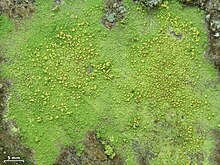| Psilolechia | |
|---|---|

| |
| Psilolechia lucida | |
| Scientific classification | |
| Domain: | Eukaryota |
| Kingdom: | Fungi |
| Division: | Ascomycota |
| Class: | Lecanoromycetes |
| Order: | Lecanorales |
| Family: | Psilolechiaceae S. Stenroos, Miadl. & Lutzoni (2014) |
| Genus: | Psilolechia A.Massal. (1860) |
| Type species | |
| Psilolechia lucida (Ach.) M.Choisy (1949) | |
| Species | |
Psilolechia is a genus of four species of crustose lichens. It is the only member of Psilolechiaceae, a family that was created in 2014 to contain this genus.
Taxonomy
The genus Psilolechia was established by Abramo Bartolommeo Massalongo in 1860. Formerly classified in the family Pilocarpaceae, molecular phylogenetic analysis showed that Psilolechia represented a distinct lineage that deserved placement at the familial level, the Psilolechiaceae, which was formally circumscribed in 2014. This arrangement was accepted in later large-scale updates of fungal classification. Psilolechiaceae is in the order Lecanorales, in the suborder Sphaerophorineae, which also includes the families Pilocarpaceae, Psoraceae, and Ramalinaceae.
Description
Psilolechiaceae is a monogeneric family of crustose lichens with effuse, ecorticate (lacking a cortex), leprose thalli formed by goniocysts (aggregations of photobiont cells surrounded by short-celled hyphae) containing Trebouxia or stichococcoid algae. The apothecia lack a distinct margin, and the asci are 8-spored and have a cylindrical to clavate shape. They feature a central, elongated tube-like structure, and a non-amyloid ascus wall surrounded by a thin outer layer. Both the tube-like structure and the thin outer layer stain dark blue in K/I. Ascospores are oblong-ovoid to tear-shaped, simple (rarely 1-septate in P. leprosa), and hyaline.
Species
Psilolechia contains four species:
- Psilolechia clavulifera (Nyl.) Coppins (1983) – widespread
- Psilolechia leprosa Coppins & Purvis (1987) – north-west Europe; Greenland
- Psilolechia lucida (Ach.) M.Choisy (1949) – widespread
- Psilolechia purpurascens Coppins & Purvis (1987) – Tasmania
Psilolechia species grow in locations that are humid and shaded. P. leprosa tends to grow on mineral-enriched rocks and siliceous rocks, and is often recorded around old mines.
References
- Massalongo, A.B. (1860). "Esame comparativo di alcune genere di licheni". Atti dell'Istituto Veneto Scienze (in Italian). 5: 247–276.
- Lumbsch, T.H.; Huhndorf, S.M. (December 2007). "Outline of Ascomycota – 2007". Myconet. 13. Chicago, USA: The Field Museum, Department of Botany: 1–58.
- ^ Miadlikowska, Jolanta; Kauff, Frank; Högnabba, Filip; Oliver, Jeffrey C.; Molnár, Katalin; Fraker, Emily; Gaya, Ester; Hafellner, Josef; Hofstetter, Valérie; Gueidan, Cécile; Otálora, Mónica A.G.; Hodkinson, Brendan; Kukwa, Martin; Lücking, Robert; Björk, Curtis; Sipman, Harrie J.M.; Burgaz, Ana Rosa; Thell, Arne; Passo, Alfredo; Myllys, Leena; Goward, Trevor; Fernández-Brime, Samantha; Hestmark, Geir; Lendemer, James; Lumbsch, H. Thorsten; Schmull, Michaela; Schoch, Conrad; Sérusiaux, Emmanuël; Maddison, David R.; Arnold, A. Elizabeth; Lutzoni, François; Stenroos, Soili (2014). "A multigene phylogenetic synthesis for the class Lecanoromycetes (Ascomycota): 1307 fungi representing 1139 infrageneric taxa, 317 genera and 66 families". Molecular Phylogenetics and Evolution. 79: 132–168. doi:10.1016/j.ympev.2014.04.003. PMC 4185256. PMID 24747130.
- Lücking, Robert; Hodkinson, Brendan P.; Leavitt, Steven D. (2017). "The 2016 classification of lichenized fungi in the Ascomycota and Basidiomycota–Approaching one thousand genera". The Bryologist. 119 (4): 361–416. doi:10.1639/0007-2745-119.4.361. S2CID 90258634.
- Wijayawardene, Nalin N.; Hyde, Kevin D.; Lumbsch, H. Thorsten; Liu, Jian Kui; Maharachchikumbura, Sajeewa S. N.; Ekanayaka, Anusha H.; Tian, Qing; Phookamsak, Rungtiwa (2018). "Outline of Ascomycota: 2017". Fungal Diversity. 88 (1): 167–263. doi:10.1007/s13225-018-0394-8. S2CID 7485476.
- Wijayawardene, Nalin; Hyde, Kevin; LKT, Al-Ani; S, Dolatabadi; Stadler, Marc; Haelewaters, Danny; Tsurykau, Andrei; Mesic, Armin; Navathe, Sudhir; Papp, Viktor; Oliveira Fiuza, Patrícia; Vázquez, Víctor; Gautam, Ajay; Becerra, Alejandra G.; Ekanayaka, Anusha; K. C., Rajeshkumar; Bezerra, Jadson; Matočec, Neven; Maharachchikumbura, Sajeewa; Suetrong, Satinee (2020). "Outline of Fungi and fungus-like taxa". Mycosphere. 11: 1060–1456. doi:10.5943/mycosphere/11/1/8. hdl:10481/61998.
- "Psilolechia". Mycobank. Retrieved 23 March 2017.
- Coppins, Brian John (1983). A Taxonomic Study of the Lichen Genus Micarea in Europe. Bulletin of the British Museum of Natural History. Vol. 11. London: British Museum (Natural History). p. 201.
- ^ Coppins, B.J.; Purvis, O.W. (1987). "A review of Psilolechia". The Lichenologist. 19 (1): 29–42. doi:10.1017/S0024282987000045. S2CID 86264849.
- Czarnota, Paweł; Kukwa, Martin (2008). "Contribution to the knowledge of some poorly known lichens in Poland. II. The genus Psilolechia". Folia Cryptog. Estonica. 44: 9–15.
- Purvis, O.W.; Halls, C. (1996). "A review of lichens in metal-enriched environments". The Lichenologist. 28 (6): 571–601. doi:10.1006/lich.1996.0052. S2CID 86235930.
| Taxon identifiers | |
|---|---|
| Psilolechia |
|
| Psilolechiaceae | |